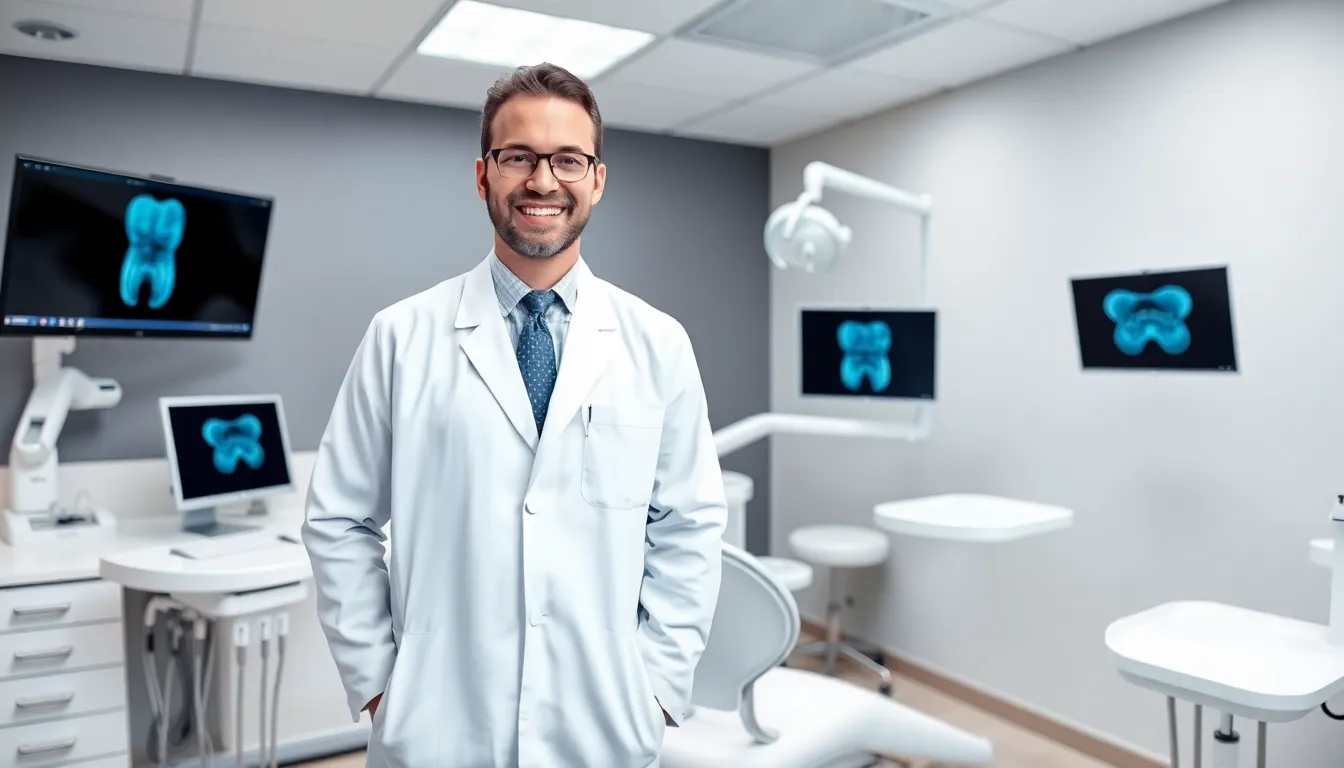In a world where smartphones can practically order pizza with a single tap, it’s about time dental care caught up. Gone are the days of waiting for a dentist to fumble with archaic tools while you awkwardly pretend to enjoy the latest gossip magazine. Enter technology-enhanced dental care, where innovation meets oral hygiene in a way that even your teeth would give a standing ovation—if they had legs.
Imagine a dental experience that’s not just about drills and floss, but smart devices and virtual consultations. With tech-savvy solutions like 3D imaging and AI-driven diagnostics, patients can now enjoy a more efficient and comfortable journey to a dazzling smile. So why settle for the old way when high-tech dental care makes the process smoother, faster, and dare we say, enjoyable? Get ready to transform your dental visits into a futuristic experience that’ll leave you grinning from ear to ear.
Table of Contents
ToggleOverview of Technology-Enhanced Dental Care
Technology-enhanced dental care represents a significant advancement in oral health services. Innovations like digital X-rays reduce radiation exposure and increase image clarity. 3D printing creates precise dental restorations, streamlining the fabrication process. AI-driven diagnostics can analyze patient data rapidly and accurately. These tools empower dental professionals to make informed decisions about treatment plans.
Tele dentistry offers virtual consultations, allowing patients to discuss dental concerns from home. Such methods increase accessibility for those living in remote areas. Additionally, intraoral cameras provide real-time visuals of a patient’s mouth, enhancing communication between dentists and patients. Patients can understand their dental conditions better, facilitating informed choices.
Laser dentistry improves procedures across various treatments, minimizing pain and recovery time. Enhanced infection control is achievable through advanced sterilization technology that ensures a safe environment. Real-time monitoring tools help track patient progress, allowing for timely adjustments in treatment.
Smart toothbrushes encourage better oral hygiene practices at home. These devices analyze brushing habits, sending feedback to users for improvement. Mobile applications also support patients in managing appointments and understanding oral health better.
Data shows that technology integration in dentistry increases patient satisfaction by offering faster, less invasive procedures. Enhanced tools and digital solutions create a more comfortable experience, making dental visits less daunting. As patients embrace these advancements, they benefit from improved oral health and a positive experience overall.
Benefits of Technology-Enhanced Dental Care

Technology-enhanced dental care brings numerous advantages for patients and dental professionals alike, revolutionizing the overall dental experience. Key benefits include improved patient experience and enhanced treatment accuracy.
Improved Patient Experience
Modern technology significantly transforms patient experience during dental visits. Digital X-rays provide instant results with minimal exposure to radiation. Patients feel more at ease with intraoral cameras that offer real-time images of their dental conditions. Tele dentistry allows individuals to consult dental professionals from the comfort of home, reducing travel and wait times. Smart toothbrushes and mobile applications help people track oral hygiene and manage appointments, leading to consistent care. Increased accessibility and comfort foster a positive atmosphere, contributing to higher patient satisfaction levels.
Enhanced Treatment Accuracy
Technological advancements also enhance treatment accuracy in dental care. 3D imaging technology offers precise visualization of dental structures, allowing for better planning of procedures. AI-driven diagnostics analyze patient data quickly and accurately, informing treatment decisions. Laser dentistry reduces errors during procedures, resulting in more effective outcomes. Advanced sterilization techniques ensure a safe environment, minimizing the risk of infection. These innovations empower dental professionals to deliver personalized treatments tailored to each patient’s unique needs, improving overall health outcomes.
Types of Technologies in Dental Care
Various technologies enhance dental care, improving patient experiences and treatment outcomes. These advancements streamline processes, making dental visits more efficient and effective.
Teledentistry
Teledentistry connects patients with dental professionals through virtual platforms. This approach allows for consultations from the comfort of home, making oral care accessible to those in remote areas. Patients can discuss concerns, receive preliminary diagnoses, and get treatment recommendations without traveling to an office. Teledentistry also facilitates follow-up consultations, reducing the need for in-person visits. Many dental practices offer teledentistry services, which can increase patient retention and satisfaction by providing flexibility in managing oral health.
Digital Impressions
Digital impressions transform the way dentists capture tooth and gum structure. This technology eliminates the need for traditional impression materials, which can be uncomfortable. Instead, scanners create accurate 3D models, enhancing the precision of dental restorations. These digital impressions facilitate quicker turnaround times, making procedures like crowns and aligners more efficient. Additionally, the use of digital impressions improves communication between dental professionals and labs, ensuring that patients receive high-quality, customized treatments swiftly.
Challenges and Considerations
Technology-enhanced dental care presents various challenges alongside its many benefits. Cost and patient acceptance are two critical areas where dental practices must focus.
Cost Implications
Investing in cutting-edge dental technology can elevate operational expenses. Equipment like digital X-ray machines and 3D printers requires substantial initial investment and ongoing maintenance. Practices may face challenges in balancing these costs with patient affordability. Some patients might hesitantly embrace high-tech options, especially if insurance coverage doesn’t fully accommodate the increased expenses. This situation could lead to decisions between adopting new technologies and maintaining accessible care for all patients.
Patient Acceptance
Acceptance of advanced dental technologies varies among patients. Comfort with new treatments often depends on individual experiences and perceptions. Many may express reluctance toward AI diagnostics or teledentistry due to unfamiliarity. Trust plays a significant role in convincing patients to engage with new methods. Providers must actively educate patients about the benefits and safety of these innovations to foster acceptance. Patient feedback remains crucial, as it helps practices adapt and enhance their approach to technology adoption.
Future Trends in Technology-Enhanced Dental Care
Emerging technologies continue to shape the future of dental care. Integration of artificial intelligence in diagnostics enhances the accuracy of patient assessments. Advanced algorithms analyze dental images and patient data quickly, leading to timely interventions.
3D printing is transforming the production of dental appliances. Customized aligners and crowns can now be manufactured on-site, reducing wait times significantly. Patients benefit from immediate solutions and precision that were previously unattainable.
Teledentistry is gaining traction in reaching patients who face mobility challenges or live in remote areas. Virtual consultations provide convenience and expand access to professional advice. Patients can discuss their concerns without needing to travel, which is especially useful for routine check-ups.
Innovations in laser technology continue to minimize discomfort during procedures. Procedures that once required anesthesia can often be done painlessly, promoting a quicker recovery. Dentists are increasingly adopting these methods to enhance patient experiences.
Mobile applications for dental care tracking are revolutionizing personal oral hygiene management. Many applications assist in scheduling appointments and sending reminders for routine cleanings. Engagement improves as patients actively manage their dental health.
Integration of smart toothbrushes is on the rise, offering feedback on brushing habits. Data collected during brushing sessions helps patients improve their techniques. Such continuous feedback fosters healthier habits and better oral hygiene.
Continuous advancements in sterilization methods ensure a safe dental environment. Innovations in equipment reduce the risk of infections, providing peace of mind for patients. Trust in the safety of dental practices is essential for encouraging regular visits.
As technology progresses, practices must carefully balance costs with benefits. Investment in cutting-edge tools can elevate operational expenses, making financial planning crucial. Patients value affordability without compromising the quality of care.
Embracing technology-enhanced dental care not only elevates the patient experience but also paves the way for more effective treatments. With innovations like AI diagnostics and teledentistry, patients can enjoy a more personalized and accessible approach to oral health.
As dental practices continue to integrate advanced technologies, the focus remains on improving outcomes while ensuring comfort and safety. The future of dentistry looks promising, with ongoing advancements poised to further transform how dental care is delivered.
Patients are encouraged to stay informed and open-minded about these innovations, as they offer significant benefits that can lead to healthier smiles and a more enjoyable dental journey.



